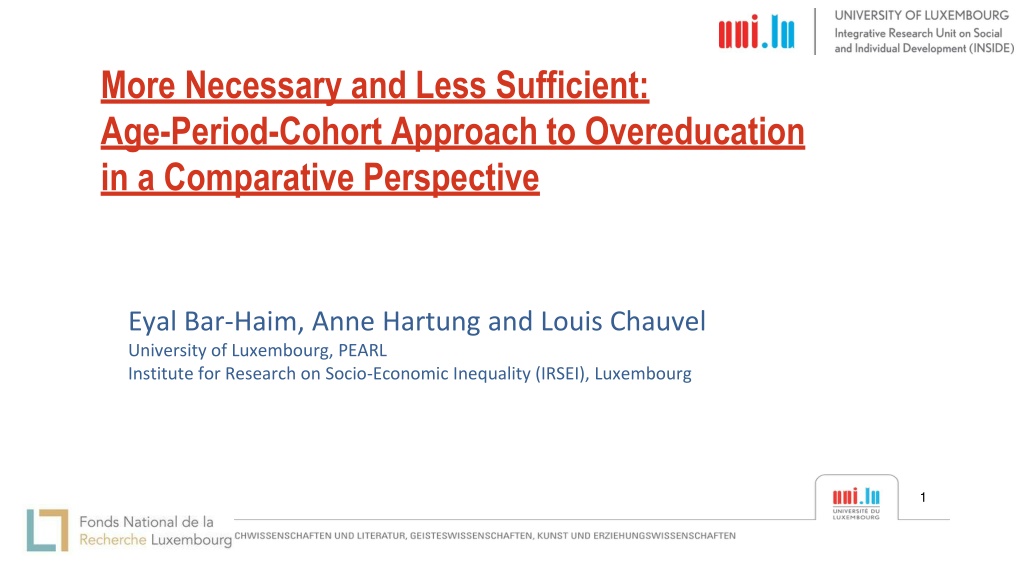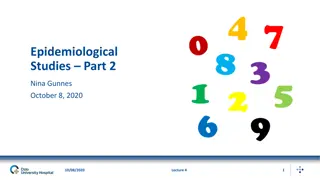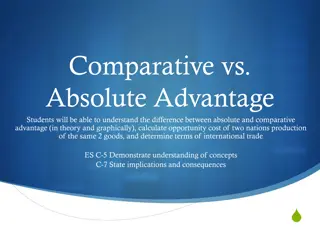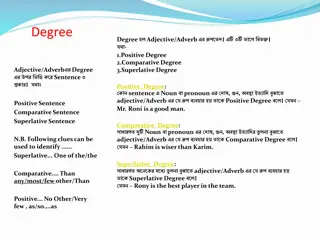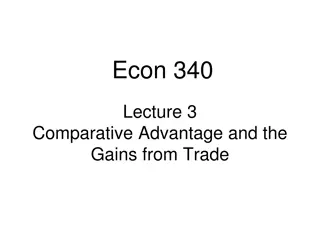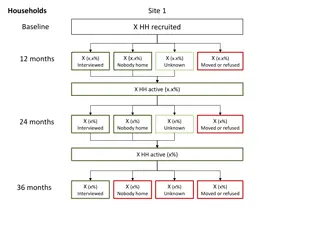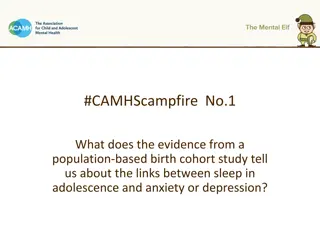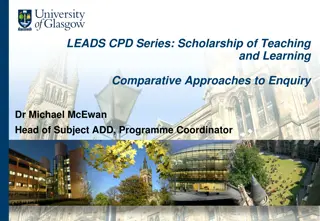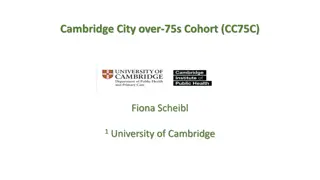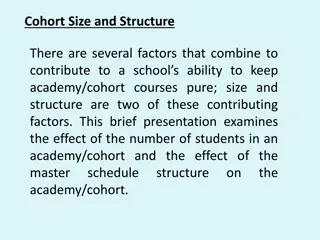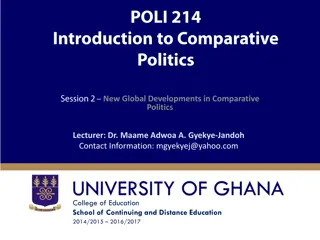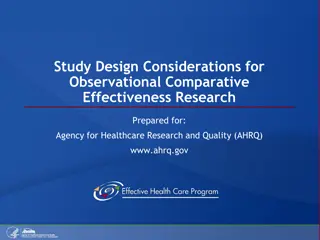Age-Period-Cohort Approach to Overeducation: Comparative Perspective
Explore the impact of structural changes on overeducation using an age-period-cohort approach. Investigate the correlation between skill-biased technological change (SBTC) and overeducation, changes in returns to education over cohorts, and effects of educational expansion on wages. Research questions focus on income gaps, returns to tertiary education, and the influence of SBTC and educational expansion.
- Overeducation
- Age-period-cohort
- Skill-biased technological change
- Comparative perspective
- Educational expansion
Download Presentation

Please find below an Image/Link to download the presentation.
The content on the website is provided AS IS for your information and personal use only. It may not be sold, licensed, or shared on other websites without obtaining consent from the author. Download presentation by click this link. If you encounter any issues during the download, it is possible that the publisher has removed the file from their server.
E N D
Presentation Transcript
More Necessary and Less Sufficient: Age-Period-Cohort Approach to Overeducation in a Comparative Perspective Eyal Bar-Haim, Anne Hartung and Louis Chauvel University of Luxembourg, PEARL Institute for Research on Socio-Economic Inequality (IRSEI), Luxembourg 1
Our aims 1. Overeducation 2. Theories and Definitions 3. Datasets & variables 4. Methodology: APCGO and apctlag 5. Results: between SBTC and educational inflation 2
Overeducation Returns to education might change due to structural changes: High skilled labor supply Skill biased technological change (SBTC) Overeducation: a decrease in the returns to education due to a structural change Might be correlated 3
Definitions of overeducation Relative to previous cohorts (at the same age) Relative to the less educated If Edu. expansion > Eco. Growth Overeducation = lower wages for higher education The gap in resources of educated juniors relative to less educated changes over time (but undereducation could happen as well!...) 4
Education is more necessary (the gap between the have and have nots increases) More growth (Skill biased) SBTC/educational expansion Education is Less Sufficient (the returns to education decline over cohorts) Educational (credential) Inflation 5
Research questions Did the income gap between the tertiary and the non-tertiary educated increase? Did the returns to tertiary education decrease over cohorts? Did the educational expansion affect the returns to education (relative to the less educated and relative to previous cohorts)? Did the SBTC affect the returns to education? 6
Data and Variables A- LIS 1985-2010 each 5 years, 12 countries => long term AT CA DE DK ES FI FR IL IT LU NL NO UK US Variables: Income: Household disposable income per consumption unit (PPP adjusted) Income rank: logit rank of DPI Education: Binary education variable(tertiary/less than tertiary) based on ISCED Skill biased occupations: Category 2 and 3 in ISCO88 Gender as control variable 7
The Data structure Combined LIS datasets (both household and individual) Structure (U.S. example) AU85 CA87 DE84 DK87 ES80 FI87 FR84 IL86 IT86 LU85 NL83 NO86 UK86 US86 AU89 CA91 DE89 DK92 ES90 FI91 FR89 IL92 IT91 LU91 NL90 NO91 UK91 US91 AU95 CA94 DE94 DK95 ES95 FI95 FR94 IL97 IT95 LU94 NL93 NO95 UK94 US94 AU01 CA98 DE00 DK00 ES00 FI00 FR00 IL01 IT00 LU00 NL99 NO00 UK99 US00 AU03 CA04 DE04 DK04 ES04 FI04 FR05 IL05 IT04 LU04 NL04 NO04 UK04 US04 AU10 CA10 DE10 DK10 ES10 FI10 FR10 IL10 IT10 LU10 NL10 NO10 UK10 US10 Age/ Period 1985 1990 1995 2000 2005 2010 25 13,603 12,227 10,572 13,126 12,512 12,941 30 13,432 13,381 12,387 15,916 14,393 13,874 35 12,059 12,859 12,356 18,278 15,717 13,928 40 9,932 11,495 11,267 18,988 17,333 15,032 45 7,806 9,306 9,930 16,119 16,207 15,114 50 6,961 7,416 7,830 12,768 13,450 14,038 55 7,024 6,379 6,294 8,737 10,470 11,870 8
Methods APCGO and apctlag (ssc install apcgo) Age-Period-Cohort methods designed to capture cohort trends APCtlag - trends in dependent variable over cohorts APCGO - trends in the gaps between two groups over cohorts 9
Structure of data Lexis table / diagram Age indexed by a from 1 to A Period by p from 1 to P Cohort by c = p a + A from 1 to C Cross-sectional surveys including one outcome y and controls x Large sample: each cell (apc) of the Lexis table has data age 10 9 8 7 6 5 4 3 2 1 10 11 12 13 14 15 16 1 2 3 cohort 4 5 6 7 8 9 10 11 12 9 10 11 12 13 9 10 11 12 13 14 9 10 11 12 13 14 15 1 2 3 4 5 6 7 8 2 3 4 5 6 7 8 3 4 5 6 7 8 5 6 7 8 9 10 11 6 7 8 9 10 7 8 9 c = p a + A 4 5 6 7 period 10
apctlag 40 years of APC debate and the last 10 years improvements APC-Detrended as an identifiable solution of age, period and cohort non linear effects (Chauvel, 2013, Chauvel and Schr der. 2014, Chauvel et al., 2016) = + + + + + + apc ( ) ( ) ( ) u rescale a rescale c APCD 0 0 0 a p c where , , p are sum zero and trend zero; and cohort tre and age absorb nd 0 0 a c 0 is the constant is a two-dimensional linear (=hyperplane) trend are 3 vectors of age, period and cohort fluctuations c p a , , + ( ) ( ) rescale a rescale c 0 0 Detrended APC works well. Trended APC & the identification problem (a=p-c ) Solution implement a relevant constraint The meaningful constraint is trend in a equate the average of the longitudinal shift observed in uapc 10
apctlag = [ (u(a+1, p+1, c) - uapc)] / [(A-1) (P-1)] is the average longitudinal age effect along cohorts (= the average difference between u(a+1, p+1, c) and its cohort lag uapc across the table) The apctlag solution age 10 9 8 7 6 5 4 3 2 1 10 11 12 13 14 15 16 1 2 3 cohort 4 5 6 7 8 9 10 11 12 9 10 11 12 13 9 10 11 12 13 14 9 10 11 12 13 14 15 1 2 3 4 5 6 7 8 2 3 4 5 6 7 8 3 4 5 6 7 8 5 6 7 8 9 10 11 6 7 8 9 10 7 8 9 = + + + apc ( ) u APCL a p c 0 = ; 0 = Trend( 0; = = where ( ) and ( ) Trend( ) ) a p p a Operator Trend for age coefficients is [ 12 ) Trend( = a + 2 ( a [(A / )] 1 - 1)A(A 1)] i A s APCtlag delivers a unique estimate of vector c a cohort indexed measure of gaps Average c is the general intensity of the gap Trend of c measures increases/decreases of the gap in the window of observation Values of c show possible non linearity The c can be compared between countries 4 5 6 7 period 11
APCGO First step: decompose the gap in each cell of the Lexis table For each cell of the Lexis Table one Blinder Oaxaca decomposition is proceeded So we transform the yapc in each cell in an aggregate: the Oaxaca- blinder unexplained part uapc Second step: we use apctlag on the unexplained gap To obtain CIs, we bootstrap the two steps together Stata: ssc install APCGO 13
Results has education expanded? Figure 1: Cohort Change in the Proportion Tertiary Education Holders DE DK ES FI .6 .4 APCtlag of the proportion of tertiary educated (controlled for gender) .2 0 FR IL IT LU .6 Proportion .4 See: ssc install apcgo .2 0 NL NO UK US .6 .4 .2 0 1940 1960 1980 1940 1960 1980 1940 1960 1980 1940 1960 1980 15 Birth cohort Graphs by cnt
Results has the gap widened (relative returns increased)? Figure 2: Economic Returns of Tertiary Relative to Non-Tertiary Educated Over Birth Cohorts DE DK ES FI 1 ln(income) gap unexplained by gender (Oaxaca decomposition) .5 Unexplained gap (ln(income)) 0 FR IL IT LU See: ssc install apcgo 1 Economic returns: household disposable income (PPP) adjusted per standard adult (DPI) .5 0 NL NO UK US 1 .5 0 1940 1960 1980 1940 1960 1980 1940 1960 1980 1940 1960 1980 16 Birth cohort Graphs by country
Results have absolute returns to tertiary education declined? Figure 3: Returns to Tertiary Education (Logit rank DPI) DE DK ES FI 3 APCtlag of the (income(controlled for gender) 2 1 0 FR IL IT LU Income ranks See: ssc install apcgo 3 2 1 0 NL NO UK US 3 2 1 0 1940 1960 1980 1940 1960 1980 1940 1960 1980 1940 1960 1980 17 Birth cohort Graphs by cnt
OLS analysis Cases: Cohort-countries (N=100 due to data limitation) Cohort coefficients obtained from apctlag and apcgo Dependent variables: Returns to education in terms of income (relative and absolute) Independent variables: Educational expansion (apctlag for tertiary education) SBTC (apctlag for in high-skilled occupations) ISCO-88 Categories 3 (professionals) and 3 (technical occupations) 18
Results: the role of educational expansion and SBTC Relative to less than tertiary Only Tertiary Model 1 Model 2 Model 3 Model 4 Expansion -0.79* -1.68* -2.06* -3.30* (0.38) (0.54) (0.34) (0.45) SBTC -0.03 -1.28 0.60 -1.15 (0.45) (0.7) (0.4) (0.58) Expansion*SBTC 4.42* 6.16* (1.91) (1.6) Constant 1.38* 1.58* 1.34* 1.62* (0.07) (0.11) (0.06) (0.09) Adj-R2 0.08 0.33 0.38 0.46 19
Results: the role of educational expansion and SBTC Relative to less than tertiary Only Tertiary Model 1 Model 2 Model 3 Model 4 Expansion -0.79* -1.68* -2.06* -3.30* (0.38) (0.54) (0.34) (0.45) SBTC -0.03 -1.28 0.60 -1.15 (0.45) (0.7) (0.4) (0.58) Expansion*SBTC 4.42* 6.16* (1.91) (1.6) Constant 1.38* 1.58* 1.34* 1.62* (0.07) (0.11) (0.06) (0.09) Adj-R2 0.08 0.33 0.38 0.46 20
Conclusions Educational expansion increased overeducation (relative or absolute) Unless strong SBTC has occurred But, SBTC for itself has no effect on overeducation In the context of educational expansion and strong SBTC change absolute as well as relative return for tertiary educated increase Tertiary education is sometimes more necessary (where relative returns increased) but usually less sufficient (as absolute returns decreased). 22
Thank You! 23
To nutshellize Logit-Rank & Applications Logit-rank transformation is a convenient tool to transform ordinal variables in ] infinite ; + infinite[ standardized distribution In the context of distributional analysis, it provides a net of distributional change relative reference position of individuals and of groups It is more convenient than percentiles levels [between 0 and 1] that present border issues Useful in income volatility analysis and in contexts where positional aspects are central 2 is close to top decile 4 is close to top 2% 0 is median logit(rank) Percentile/rank 0.018 0.047 0.119 0.269 0.500 0.731 0.881 0.953 0.982 -4 -3 -2 -1 0 1 2 3 4 1 is close to top quartile 3 is close to top vingtile 24
Logit ranks based education income gap DE DK ES FI 3 2 1 0 FR IL IT LU 3 2 1 0 NL NO UK US 3 2 1 0 1940 1960 1980 1940 1960 1980 1940 1960 1980 1940 1960 1980 25 Birth cohort Graphs by country
